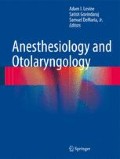Abstract
Modern surgical practice necessitates safe and efficient management of the airway in order to administer anesthesia in a controlled manner. It is the primary role and responsibility of the anesthesiologist to assess, secure, and monitor a patient’s airway in the perioperative setting. Although performed on a daily basis in seemingly routine fashion, unanticipated problems in airway management will be encountered by even the most skilled anesthesiologist in anywhere from 1 % to 3 % of patients undergoing general endotracheal anesthesia [1]. The effective identification of such potentially “difficult” airways should be the focus of the preoperative assessment by both surgeon and anesthesiologist in order to develop a coordinated plan of care and minimize the risk of precipitating a true airway emergency.
Access this chapter
Tax calculation will be finalised at checkout
Purchases are for personal use only
References
Wilson ME, Spiegelhalter D, Robertson JA, et al. Predicting difficult intubation. Br J Anaesth. 1988;61(2):211–6.
Mallampati SR, et al. A clinical sign to predict difficult intubation: a prospective study. Can Anaesth Soc J. 1985;32:429.
Samsoon GL, Young JR. Difficult tracheal intubation: a retrospective study. Anaesthesia. 1987;42:487–90.
Hester CE, Dietrich SA, White SW, et al. A comparison of preoperative airway assessment techniques: the modified Mallampati and the upper lip bite test. AANA J. 2007;75:177–82.
Myneni N, O’Leary AM, Sandison M, et al. Evaluation of the upper lip bite test in predicting difficult laryngoscopy. J Clin Anesth. 2010;22:174–8.
Rosenblatt W, Ianus AI, Sukhupragarn W, et al. Preoperative endoscopic airway examination (PEAE) provides superior airway information and may reduce the use of unnecessary awake intubation. Anesth Analg. 2011;112:602–7.
Practice Guidelines for Management of the Difficult Airway: an updated report by the American Society of Anesthesiologists Task Force on Management of the Difficult Airway. Anesthesiology 2003; 98:1269.
Benumof JL. Laryngeal mask airway and the ASA difficult airway algorithm. Anesthesiology. 1996;84(3):686–99.
Cooper RM. Safe extubation. Anesth Clin North Am. 1995;13:683.
Brain AIJ. The laryngeal mask: a new concept in airway management. Br J Anaesth. 1983;55:801.
Agro F, Frass M, Benumof JL. Current status of the Combitube: a review of the literature. J Clin Anesth. 2002;14:307–14.
Edens ET, Sia RL. Flexible fiberoptic endoscopy in difficult intubations. Ann Otol Rhinol Laryngol. 1981;90(4 Pt 1):307–9.
Cooper RM. Use of a new videolaryngoscope (GlideScope®) in the management of a difficult airway: [L’usage d’un nouveau videolaryngoscope (GlideScope®) pour une intubation difficile]. Can J Anesth. 2003;50:611–3.
Aziz MF, Healy D, Kheterpal S, et al. Routine clinical practice effectiveness of the Glidescope in difficult airway management: an analysis of 2,004 Glidescope intubations, complications, and failures from two institutions. Anesthesiology. 2011;114:34–41.
McCarroll SM, Lamont BJ, Buckland MR, et al. The gum-elastic bougie: old but still useful. Anesthesiology. 1988;68:643–4.
Benumof JL. Management of the difficult airway with special emphasis on awake tracheal intubation. Anesthesiology. 1991;75:1087–110.
Reed AP, Han DG. Preparation of the patient for awake fiberoptic intubation. Anesth Clin North Am. 1991;9:69.
Henderson JJ, Popat MT, Latto IP, Pearce AC. Difficult airway society guidelines for management of the unanticipated difficult intubation. Anaesthesia. 2004;59:675.
Bigenzahn W, Pesan B, Frass M. Emergency ventilation using the Combitube in cases of difficult intubation. Eur Arch Ororhinolaryngol. 1991;248:129–31.
Ferson DZ, Rosenblatt WH, Johansen MJ, Osborn I, Ovassapian A. Use of the intubating LMA-Fastrach in 254 patients with difficult-to-manage airways. Anesthesiology. 2001;100:114–50.
Mort TC. Tracheal tube exchange: feasibility of continuous glottic viewing with advanced laryngoscopy assistance. Anesth Analg. 2009;108:1228–31.
Bedger Jr RC, Chang JL. A jet-stylet endotracheal catheter for difficult airway management. Anesthesiology. 1987;66:221–3.
Mort TC. Continuous airway access for the difficult extubation: the efficacy of the airway exchange catheter. Anesth Analg. 2007;105:1357–62.
Morain WD. Cricothyroidostomy in head and neck surgery. Plast Reconstr Surg. 1980;65(4):424–8.
Bainton CR. Cricothyrotomy. Int Anesthesiol Clin. 1994;32(4):95–108.
Altman KW, Waltonen JD, Kern RC. Urgent surgical airway intervention: a 3-year county hospital experience. Laryngoscope. 2005;115:2101.
Benumof J, Scheller MS. The importance of transtracheal jet ventilation in the management of the difficult airway. Anesthesiology. 1989;71:769–78.
Redel A, Karademir F, Schlitterlau A, Frommer M, Scholtz LU, Kranke P, Kehl F, Roewer N, Lange M. Validation of the GlideScope video laryngoscope in pediatric patients. Paediatr Anaesth. 2009;19(7):667–71.
Guldfred LA, Lyhne D, Becker BC. Acute epiglottitis: epidemiology, clinical presentation, management and outcome. J Laryngol Otol. 2008;122(8):818–23. Aug.
Al-Qudah M, Shetty S, Alomari M, Alqdah M. Acute adult supraglotittis: current management and treatment. South Med J. 2010;103(8):800–4. Aug.
Seidman MD, Lewandowski CA, Sarpa JR, Potesta E, Schweitzer VG. Angioedema related to angiotensin-converting enzyme inhibitors. Otolaryngol Head Neck Surg. 1990;102(6):727–31. Jun.
Andreassen UK, Baer S, Nielsen TG, Dahm SL, Arndal H. Acute epiglottitis: 25 years experience with nasotracheal intubation, current management policy and future trends. J Laryngol Otol. 1992;106(12):1072–5. Dec.
Von Ludwig WF. Über eine in neuerer Zeit wiederholt hier vorgekommene Form von Halsentzündung. Medicinisches Correspondenzblatt des Württembergischen ärztlichen Vereins, Stuttgart. 1836;6:21–5.
Schwartz HC, Bauer RA, Davis NJ, et al. Ludwig‘s angina: use of fiberoptic laryngoscopy to avoid tracheostomy. J Oral Surg. 1974;32(8):608–11.
Mulder DS, Wallace DH, Woolhouse FM. The use of the fiberoptic bronchoscope to facilitate endotracheal intubation following head and neck trauma. J Trauma. 1975;15(8):638–40.
Mace SE. Blunt laryngotracheal trauma. Ann Emerg Med. 1986;15(7):836–42.
Author information
Authors and Affiliations
Corresponding author
Editor information
Editors and Affiliations
Rights and permissions
Copyright information
© 2013 Springer Science+Business Media New York
About this chapter
Cite this chapter
Osborn, I.P., Kleinberger, A.J., Gurudutt, V.V. (2013). Airway Management, Emergencies and the Difficult Airway. In: Levine, A., Govindaraj, S., DeMaria, Jr., S. (eds) Anesthesiology and Otolaryngology. Springer, New York, NY. https://doi.org/10.1007/978-1-4614-4184-7_8
Download citation
DOI: https://doi.org/10.1007/978-1-4614-4184-7_8
Published:
Publisher Name: Springer, New York, NY
Print ISBN: 978-1-4614-4183-0
Online ISBN: 978-1-4614-4184-7
eBook Packages: MedicineMedicine (R0)

